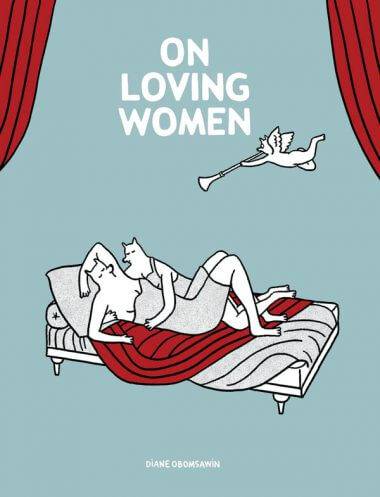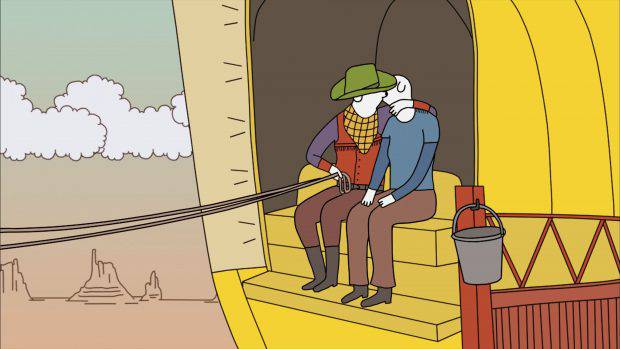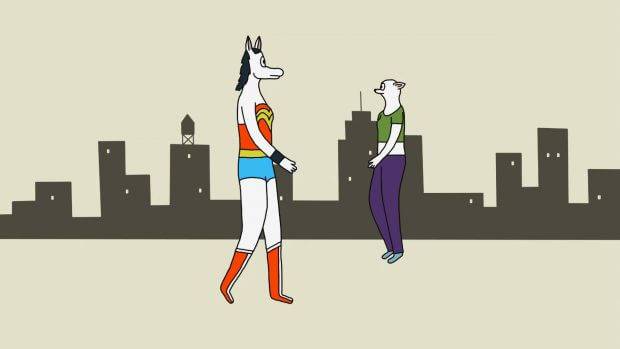Interview with Diane Obomsawin (‘I Like Girls’/’On Loving Women’)
Diane Obomsawin (also known by her pen-name Obom) has been a staple of the Montreal underground comics scene since the mid-80s, having moved to Canada after growing up. Cutting her teeth in the world of animation while studying at Concordia Univeristy, since the late 90s she has enjoyed a harmonious relationship with the National Film Board of Canada, producing several commissioned films dealing with civil law and personal rights before her first original animated short Here and There, an autobiographical film based on her tumultuous childhood which went on the win Best Narrative Short Animated at the Ottawa International Animation Festival in 2006.
Subsequent films have been based on Diane’s acclaimed work as a comic book writer and artist, with her 2008 award-winning graphic novel Kaspar (inspired by the life of Kaspar Hauser) adapted into a similarly accoladed NFB film in 2012. Among her most recent comic projects is J‘aime les Filles, a collection of ten reflections by women on their first loves, exploring topics such as coming out, early attempts at sexual expression, affection both reciprocated and not, all presented with honest humour and pathos. The ‘ordinariness’ and relatability of each memoir makes them all the more compelling, with Diane’s distinct illustration style – in which people are depicted with animal heads that vary from story to story – imbuing them with an apropos sense of naivety.
At times explicitly sexual, there’s no sense of an impetus to provoke, shock or titillate; these sequences instead serve to round out of the authenticity of each recollection, appearing alongside bizarrely endearing anecdotal details that range from eating ice-cream cones dunked in cola to coveting a brother’s parking garage playset. Although the stories are bound by the theme of women’s affection for women, there’s a universal accessibility inherent in its loftier themes of yearning, rejection, adolescent confusion and, in its cheerier moments, the unbridled joy of romantic dreams coming true. Having been translated to English as On Loving Women by renowned Canadian publisher Drawn & Quarterly (who also released an English translation of Kaspar), four of the ten stories have this year been adapted into the animated short film I Like Girls. Produced by Marc Bertrand (whose recent NFB credits also include Blind Vaysha, Monsieur Pug, Jutra, No Fish Where To Go, Sunday and Theo Ushev’s 20th Century Trilogy) the film has already been critically acclaimed and garnered the Grand Prize for Independent Short at this year’s OIAF.
I Like Girls will be screening at Sommets du cinéma d’animation which takes place at Montreal’s Cinémathèque québécoise this week and will feature a special presentation/workshop event hosted by the director herself. We spoke with Diane about liking girls, loving women and the challenges and compromises of adapted one visual storytelling medium to another.
Prior to animation your background is as an underground comic artist, what brought you into that world?
It was because I never stopped drawing when I was a kid, I was doing drawings and comics either as a way for me to make my mother laugh or to express my anger. I had a stepbrother who was much older than me who was at university doing Fine Arts, so I realised I could just draw all my life.
So was the scene in Montreal quite nurturing for drawing and animation?
It was incredible. I can say that for the past six or maybe ten years there’s been an explosion of underground animation, it’s flourishing in Montreal more than ever.
And did you first start animating in the early 90s?
Yeah, quite late actually, in my late-thirties. For a long time everybody, especially one of my friends, said “You really should go into animation, your style is already asking to be animated”, she insisted I go to Concordia first to learn a little bit of animation. I just went for a few hours each week, but it was enough just to do my film, a 16mm student film that I still like. I made a one minute film in the first year, a one-minute film in the second year and two one-minute films in the third year. So it was good for me that at the end I had four films, and with those I went to the NFB where I started what was a perfect transition, doing commissioned films. They were called ‘auteur’ commissions because I could do them in my own style, my humour and point of view. So the transition was natural with the NFB. Then after three commissioned films I could do a personal film.
Were these the films on civil law?
Exactly.
Did they have a brief, essentially, and then you were charged with coming up with the scenarios?
Yeah, I was initially afraid because there was a lawyer who was very involved with the writing. I was afraid that he’d put too much of himself in the project, but he was very open-minded and it wasn’t difficult to work with him.
So when it came to moving on to your own film, did you have a pre-existing idea for a while or was it from scratch?
No, it was about my youth. I had a very chaotic youth and at one point I said “Okay, I have to write this down and then make a comic strip of my childhood”. When I went to the NFB I didn’t propose that at all, I proposed an adaptation of Mozart’s The Magic Flute and I began that. Everybody was okay with that project, but one morning I came in with my ten page comic of my childhood and my producer said “Ooh, that would make a better film”. So I made a film from that little comic, those stories.
So a few of the films have originated as comics, do you find that it’s an easier way to generate ideas for a film?
I think so, because it’s the storytelling aspect of it that makes it easy for me to do storyboarding. Then it’s completely different after that. I like to tell stories, I think if I didn’t have the capacity to draw I would be a verbal storyteller. It’s strange because doing a comic book I find more difficult, because I have to make a lot of decisions more often, for each panel I have to choose how to do it well, the best way to do the framing, I have to think with each panel. So the drawing is quite fast but afterwards there are other problems to solve for the next panel. Animation is the opposite, I just do what I’ve decided to do and don’t think so much. With comics it’s more difficult, I’ll want to make coffee and muffins all the time, do other things, but when I have a film I have to run after it, I run and run and don’t stop.
So the genesis for I Like Girls was originally a comic as well, where did that idea come from initially?
It came from one day when I realised that for many years I was always in love with someone. It was a pattern that came from childhood. I tell that anecdote in the film, that I went to about fourteen different schools and I would unconsciously find a girl who I would fall in love with intuitively, from the age of four. That was my raison de vivre, I’d want to go to school to see her and focus on that. Looking back I realised the first thing I did when I was in a new school was choose someone who would be important to me and with whom I didn’t speak, just to know she’s there. I kept doing this all my life. Then I was interested in knowing about other girls, and also at the same time I was reading from a book by Michel Tremblay, a well-known gay Quebecois author who explained that when he was 16 he noticed that each time he saw a man and a woman kissing on the cover of a book, he always identified with the woman receiving the kiss, and realised that maybe he was more attracted to men. So my question for my friends was not about their very first love, it was the very first attraction, even semi-unconsciously, toward a woman.
In the film I had to do a very concentrated version. In the book it’s ten different stories separated into chapters that have the name of each woman. The first woman I interviewed spoke for two hours and was completely depressed after that because it came with some pain for her. So afterwards I told my friends not to speak for more than twenty minutes!
When the comic was released originally what sort of response did it get?
The thing that touched me the most was the fact that the people I interviewed said that they totally recognised themselves yet, at the same time, there was enough of a distance that they could love themselves. I was really pleased with that, there was a sense that I didn’t betray what they said at all. Maybe because of the animal heads it helped them to de-dramatise or distance themselves, but at the same time they totally recognised themselves.
Having previously adapted Kaspar, was that a similar experience or did it come with its own set of challenges?
It was similar in that it gives another visual aspect completely from from the comics, another visual aspect completely. There are a lot of things missing in the storytelling but there is maybe more in terms of a feeling and atmosphere. I think it’s because of the sound and the rhythm, there are people who laugh more from some scenes that are in my film just because of the rhythm and the voices, the way they say it, than in the comic.
With I Like Girls you’ve said that you used rotoscoping for the animation itself – had you used that process at all in your earlier work?
I did a little bit with Kaspar, but with me just at home with a camera, because the film had tiny gestures that I wanted to be sure were the right ones, so I filmed myself. We often say that animators are actors, but usually the traditional animators have a mirror beside them to do the action and then reproduce it. But as a not-quite-as-good animator I prefer the technique of rotoscoping.
It comes from my lack of knowledge, but I don’t think it’s a bad thing that if you have a lack of knowledge you’re able to go another way.
I think it works very well, and save for a couple of instances I Like Girls definitely succeeds in not looking rotoscoped, whereas usually it’s a very identifiable process.
For I Like Girls it was important that because I really wanted to make a sensual film. My style of drawing is not naturally sensual, so I wanted to really be sure that the gestures were. Also it’s difficult to animate two bodies together that are kissing or caressing, so we hired two dancers, because they understand the movement, more than actors.
So you picked some of the stories from the book for the film, but not all of them, was that just for time or were there specific determining factors in which ones got picked?
I think it’s the last time I will do that, if I had to do my film again I would add maybe two more stories. I was afraid that eight minutes was long enough, but it goes by very fast. If it were fifteen minutes it could add a little something, but I still appreciate my film the way it is. That’s the thing you do when you finish a film, questioning how it could be better.
The English translation of the original comic On Loving Women is available to buy from Drawn & Quarterly.
I Like Girls will screen this week at Montreal’s Sommets du cinéma d’animation as part of International Competition 2, which runs Friday 25th 7pm and Sunday 27th 1pm at the Cinémathèque québécoise. Festivalgoers will also be able to take part in the 5-hour event A Day with Diane Obomsawin in which Diane will present her creative work, followed by a unique animated GIF workshop, on Thursday 24th from 10am.





